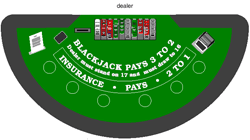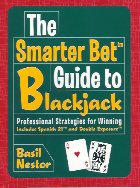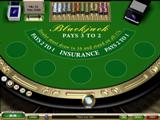ReadyBetGo's Guide to Blackjack
Blackjack Basic Rules and StrategiesBlackjack Game Flow
Blackjack Plays: Insurance, Hit, Stand, Double, or SplitBlackjack: Bad Play vs. StrategyBlackjack Basic StrategyLower the House Edge in BlackjackBlackjack Probability and the House EdgeBlackjack Terms
Smarter Bet Guide to Blackjack
by Basil Nestor
Strategy is the key to success at the blackjack table; that's a mathematical fact, and you can count on these expert, easy-to-learn tactics to make you a victor. Here's the deal: everything begins with the basic rules, and they're laid out on these pages with smart little “factoid” tips. Go through blackjack economics, which explain why cards fall the way they do, and what makes a good (and a sucker) bet. Easy-to-follow tables suggest strategies for splitting pairs and soft hands and provide dozens of other statistics and card probabilities.
Casino Tropez Blackjack
Casino Tropez is an excellent choice for players who want to play blackjack against a low house edge. Regular blackjack, with a 0.52% edge, is offered, but for even a better deal, go with Blackjack Surrender where the edge is only 0.48% using basic strategy. You can play up to an amazing 5 hands per round at either game. Casino Tropez also has the entertaining Blackjack Switch and old-time favorite, Pontoon. For great blackjack action, we recommended Casino Tropez.
The Flow of the Game of Blackjack
by Basil Nestor
Now that we’ve covered the basic rules of blackjack, let’s take a closer look at how the game is actually played. Keep in mind that in almost every case a rule variation (such as multiple Basil Nestor is the author of the new Playboy Complete Guide to Casino Gambling. This wonderful book teaches players how to avoid sucker bets and win more when playing gambling games. He is also the author of The Smarter Bet Guide series for video poker, slots, craps, and many other books about gambling. Basil's website is www.smarterbet.com decks rather than a single deck) has an effect on the casino's advantage. There are dozens of these variations, so I’ll just mention them here, and we’ll review them later in depth.
Basil Nestor is the author of the new Playboy Complete Guide to Casino Gambling. This wonderful book teaches players how to avoid sucker bets and win more when playing gambling games. He is also the author of The Smarter Bet Guide series for video poker, slots, craps, and many other books about gambling. Basil's website is www.smarterbet.com decks rather than a single deck) has an effect on the casino's advantage. There are dozens of these variations, so I’ll just mention them here, and we’ll review them later in depth.
 Basil Nestor is the author of the new Playboy Complete Guide to Casino Gambling. This wonderful book teaches players how to avoid sucker bets and win more when playing gambling games. He is also the author of The Smarter Bet Guide series for video poker, slots, craps, and many other books about gambling. Basil's website is www.smarterbet.com decks rather than a single deck) has an effect on the casino's advantage. There are dozens of these variations, so I’ll just mention them here, and we’ll review them later in depth.
Basil Nestor is the author of the new Playboy Complete Guide to Casino Gambling. This wonderful book teaches players how to avoid sucker bets and win more when playing gambling games. He is also the author of The Smarter Bet Guide series for video poker, slots, craps, and many other books about gambling. Basil's website is www.smarterbet.com decks rather than a single deck) has an effect on the casino's advantage. There are dozens of these variations, so I’ll just mention them here, and we’ll review them later in depth.Here’s the Deal
Blackjack is played at a table like the one below. Note that important rules are always printed on the table cover. Additional rules will be on an upright plastic or Plexiglas card next to the dealer. Some casinos offer single-deck games in which the dealer actually holds the deck as she distributes the cards, but most casinos have multiple-deck games. Four to eight decks are stored in a box called a shoe. The dealer pulls cards from a slot at the front of the shoe (we’ll discuss dealing and shuffling in a later article).
 This is a standard blackjack table. Note the house rules printed at the center of the table and on the upright plastic card next to the dealer.
This is a standard blackjack table. Note the house rules printed at the center of the table and on the upright plastic card next to the dealer.Players’ cards are usually dealt face-down in a single-deck game. Multiple-deck games are usually dealt face-up. Your chances of winning are the same either way, though there are some practical differences between the two methods. Players handle cards when they’re dealt face-down, but they’re usually not allowed to touch cards when they’re dealt face-up. Some people enjoy holding cards, but it’s strictly a personal preference. Concealed faces offer no advantage.
Getting into a game is easy. Just choose a table and sit in an available seat. Any seat is fine. You have an equal chance of winning at all of them. Lay some money on the felt, and the dealer will take the money and give you chips. Then put a wager in the circle in front of you and don’t touch the chips again. You’ll either lose them at the end of the hand, or you’ll win and be given more chips by the dealer.
The seat to the dealer’s far left (player’s right) is commonly called “first base.” The seat at the other end of the table is “third base.” The terminology is of no consequence in the game, but knowing it may help you in a conversation with an experienced blackjack player.
Starting on her left, the dealer gives one card to each player and then one card face-up to herself. A second card is dealt to each player and the dealer receives another card called the hole card. This time it’s face-down.
Thus you can see only one of the dealer’s cards. Let’s say it’s a 9. Does the dealer have an ace in the hole, giving her 20? Does the dealer have 18? Does the dealer have 13? If you have 21 or 20 it doesn’t matter; you’ll stand and probably win or push. But what if you have 16? Should you hit? What’s that other card?
Let's answer those questions in the next section of ReadyBetGo's Guide to Blackjack
The preceding material is just a sample of what you'll find in Basil Nestor's Smarter Bet Guide to Blackjack.
[ learn more blackjack! ]

